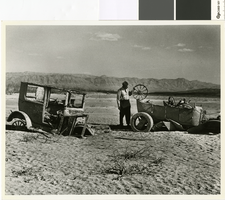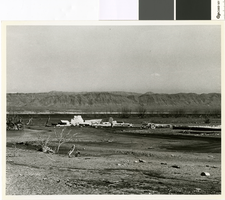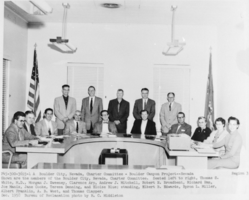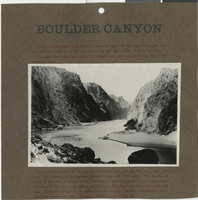Search the Special Collections and Archives Portal
Search Results

Transcript of interview with Linda Rivera by Layne Karafantis, October 2, 2009
Date
Archival Collection
Description
Text

Photograph of two cars abandoned by their owners in St. Thomas, Nevada, April 11, 1948
Date
Archival Collection
Description
Remains of two cars, most likely near the remains of Hugh Lord's shop, in St Thomas, Nevada, when the town emerged from the waters of Lake Mead in 1945
Transcribed Notes: Bureau of Reclamation typed notes appended to back of photo: Boulder Canyon Project--Nevada--Region 3 St. Thomas, Nevada, was founded by the Mormons in 1855. In its heyday there were about 800 residents in the village. The "Main Street" was a part of the old Arrowhead Trail, which led from Salt Lake City, Utah to Los Angeles, California. In June 1938 the town was abandoned by its residents, which at that time were few in number because of the rising waters of Lake Mead that submerged the townsite. Photograph shows a closeup of two cars abandoned by their owners. Note the wide wooden wheel on the car to the right; also, the smaller wheel with wooden spokes. The wide wooden wheel was used as an "engine" to pump water, the belt being placed on this wooden wheel.
Image

Photograph looking southeast through the remains of the post office in St. Thomas, Nevada, 1948
Date
Archival Collection
Description
The remains of the St. Thomas post office and Harry Gentry's store with Lake Mead in the background
Transcribed Notes: Bureau of Reclamation typed notes appended to back of photo: Boulder Canyon Project--Nevada--Region 3 St. Thomas, Nevada, was founded by the Mormons in 1855. In its heyday there were about 800 residents in the village. The "Main Street" was a part of the old Arrowhead Trail, which led from Salt Lake City, Utah to Los Angeles, California. In June 1938 the town was abandoned by its residents, which at that time were few in number because of the rising waters of Lake Mead that submerged the townsite. In 1945, after having been flooded for 7 years, receding waters of Lake Mead revealed St. Thomas much as it has appeared in former years. This photo was taken looking toward Mormon Mesa. The receding waters of the lake can be seen in the center of the photo.
Image

Film transparency of the Boulder City, Nevada Charter Committee, December 1958
Date
Archival Collection
Description
Image
Clark County Central Labor Council Records
Identifier
Abstract
The Clark County Central Labor Council Records date from 1938 to 1968 and represent Ragnold Fyhen's written account of how the Clark County Central Labor Council union was formed. The work includes the activities and meetings of the labor union and Fyhen's work (1933-1947) while Secretary-Treasurer of the Central Labor Council. This work is entitled "Labor Notes." Additionally the collection contains a resolution submitted to the Central Labor Council in 1938 in regards to proposing new legislation to regulate the Clark County hospital.
Archival Collection

Photograph of Black Canyon, circa early 1900s
Date
Archival Collection
Description
Image
Las Vegas Chamber of Commerce Records
Identifier
Abstract
The Las Vegas Chamber of Commerce Records (1911-2020) contain organizational documents from the Chamber’s history, including administrative and financial records, legal documents such as ordinances and legislation, newsletters and promotional guides, advertising and publicity materials for the city and its retailers, and original photographic prints, negatives, and reproductions. The collection also contains audiovisual materials featuring Las Vegas Chamber of Commerce events from approximately 1997 to 2013.
Archival Collection
Hinds, James R.
James Roland Hinds, better known as Jim, was the Nellis Air Force base historian and a novelist in Las Vegas, Nevada. He was born in Okmulgee, Oklahoma on December 8, 1937. Shortly after his birth, his parents became civil service employees and moved the family to Washington, D.C., where James grew up. He recieved his bachelor's from Washington University in St. Louis, Missouri and his master's degree from Southern Illinois University in 1964. After that, he served in the United States Army for two years.
Person
Gragson, Oran K. (Oran Kenneth), 1911-2002
Politician Oran Kenneth Gragson was the longest serving mayor of Las Vegas, Nevada, a position he held from 1959 to 1975. He was born February 14, 1911, near Tucamari, New Mexico. In 1919, his family moved to Arkansas, then later to Texas. Gragson came to the Las Vegas area in 1932, and worked at the Hoover Dam for a short time before finding employment in highway construction. He managed the Boulder Inn Casino and Dance Hall for a brief time, and later opened the North Main Furniture Store, followed by the Charleston Appliance Center.
Person

Transcript of interview with Louis Evans by Jeannettte Lonpergan, February 17, 1976
Date
Archival Collection
Description
On February 17, 1976, Jeannette Lonpergan interviewed well driller and dairy worker, Mr. Louis Evans (born on August 8th, 1914 in Jones County, Iowa) in his home in Las Vegas, Nevada. Mrs. Lonpergan’s husband, Mr. Dennis Lonpergan, was present during the interview and joined in on the discussion. Mr. Louis Evans’ wife, Mrs. Evans, was also present during the interview. Mr. Evans relocated to Nevada from Iowa in search of employment. Construction on the Hoover Dam had begun at this point; Mr. and Mrs. Evans recall their earliest recollections of Nellis Air Force Base and McCarran Airport. The interview covers the history of Nevada from Mr. Evans’ perspective. Mr. Evans discusses the paving of roads, employment, religious activities, housing developments, early above ground atomic tests, social and environmental changes and mining in Nevada.
Text
